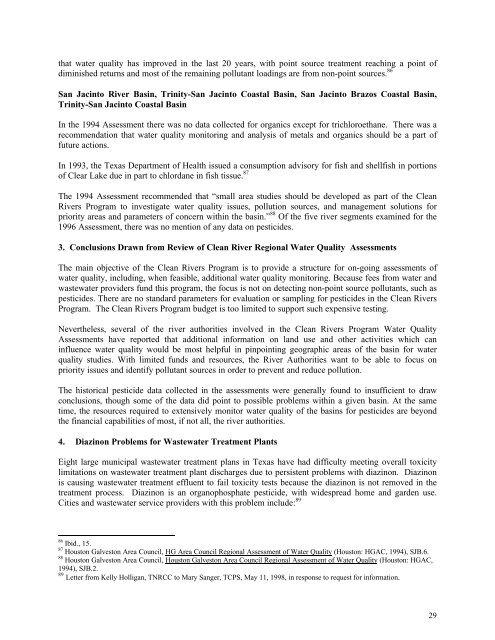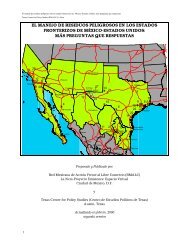Pesticides and Water Quality - Texas Center for Policy Studies
Pesticides and Water Quality - Texas Center for Policy Studies
Pesticides and Water Quality - Texas Center for Policy Studies
Create successful ePaper yourself
Turn your PDF publications into a flip-book with our unique Google optimized e-Paper software.
that water quality has improved in the last 20 years, with point source treatment reaching a point ofdiminished returns <strong>and</strong> most of the remaining pollutant loadings are from non-point sources. 86San Jacinto River Basin, Trinity-San Jacinto Coastal Basin, San Jacinto Brazos Coastal Basin,Trinity-San Jacinto Coastal BasinIn the 1994 Assessment there was no data collected <strong>for</strong> organics except <strong>for</strong> trichloroethane. There was arecommendation that water quality monitoring <strong>and</strong> analysis of metals <strong>and</strong> organics should be a part offuture actions.In 1993, the <strong>Texas</strong> Department of Health issued a consumption advisory <strong>for</strong> fish <strong>and</strong> shellfish in portionsof Clear Lake due in part to chlordane in fish tissue. 87The 1994 Assessment recommended that “small area studies should be developed as part of the CleanRivers Program to investigate water quality issues, pollution sources, <strong>and</strong> management solutions <strong>for</strong>priority areas <strong>and</strong> parameters of concern within the basin.” 88 Of the five river segments examined <strong>for</strong> the1996 Assessment, there was no mention of any data on pesticides.3. Conclusions Drawn from Review of Clean River Regional <strong>Water</strong> <strong>Quality</strong> AssessmentsThe main objective of the Clean Rivers Program is to provide a structure <strong>for</strong> on-going assessments ofwater quality, including, when feasible, additional water quality monitoring. Because fees from water <strong>and</strong>wastewater providers fund this program, the focus is not on detecting non-point source pollutants, such aspesticides. There are no st<strong>and</strong>ard parameters <strong>for</strong> evaluation or sampling <strong>for</strong> pesticides in the Clean RiversProgram. The Clean Rivers Program budget is too limited to support such expensive testing.Nevertheless, several of the river authorities involved in the Clean Rivers Program <strong>Water</strong> <strong>Quality</strong>Assessments have reported that additional in<strong>for</strong>mation on l<strong>and</strong> use <strong>and</strong> other activities which caninfluence water quality would be most helpful in pinpointing geographic areas of the basin <strong>for</strong> waterquality studies. With limited funds <strong>and</strong> resources, the River Authorities want to be able to focus onpriority issues <strong>and</strong> identify pollutant sources in order to prevent <strong>and</strong> reduce pollution.The historical pesticide data collected in the assessments were generally found to insufficient to drawconclusions, though some of the data did point to possible problems within a given basin. At the sametime, the resources required to extensively monitor water quality of the basins <strong>for</strong> pesticides are beyondthe financial capabilities of most, if not all, the river authorities.4. Diazinon Problems <strong>for</strong> Wastewater Treatment PlantsEight large municipal wastewater treatment plans in <strong>Texas</strong> have had difficulty meeting overall toxicitylimitations on wastewater treatment plant discharges due to persistent problems with diazinon. Diazinonis causing wastewater treatment effluent to fail toxicity tests because the diazinon is not removed in thetreatment process. Diazinon is an organophosphate pesticide, with widespread home <strong>and</strong> garden use.Cities <strong>and</strong> wastewater service providers with this problem include: 8986 Ibid., 15.87 Houston Galveston Area Council, HG Area Council Regional Assessment of <strong>Water</strong> <strong>Quality</strong> (Houston: HGAC, 1994), SJB.6.88 Houston Galveston Area Council, Houston Galveston Area Council Regional Assessment of <strong>Water</strong> <strong>Quality</strong> (Houston: HGAC,1994), SJB.2.89 Letter from Kelly Holligan, TNRCC to Mary Sanger, TCPS, May 11, 1998, in response to request <strong>for</strong> in<strong>for</strong>mation.29




